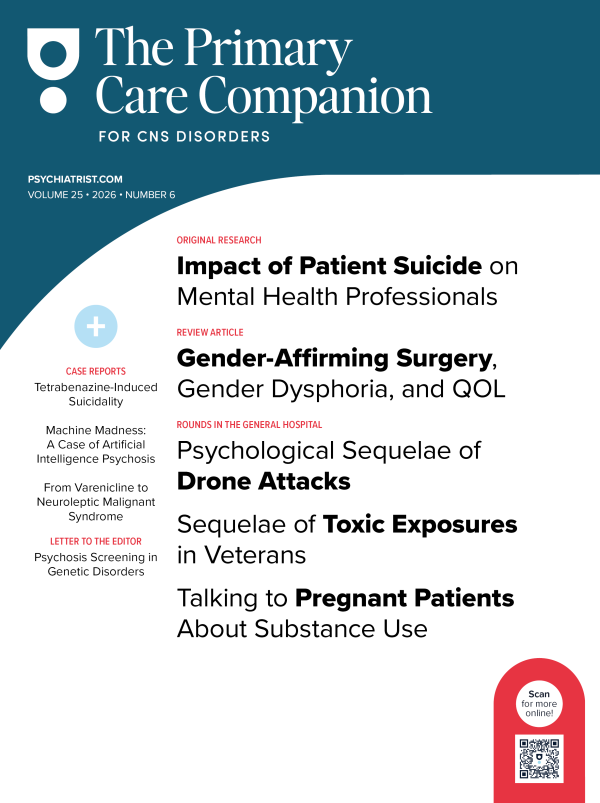A Case of Interdose Discontinuation Symptoms With Venlafaxine Extended Release
To the Editor: Venlafaxine extended release (XR) is a serotonin-norepinephrine reuptake inhibitor that, like many other antidepressants, may be associated with a discontinuation syndrome. Discontinuation syndromes are, in part, related to drugs with short half-lives1 (eg, for venlafaxine and its metabolite, 5 and 11 hours, respectively). Venlafaxine XR discontinuation symptoms have been clinically reported as soon as 6 hours2 and as long as 9 days3 after discontinuation of the drug, but typically emerge in 1-4 days.4 In one study, the prevalence of typical discontinuation symptoms with venlafaxine XR (eg, dysphoria, headaches, nausea, irritability, emotional lability, sleep disturbance) was 27%.5 However, discontinuation symptoms may be severe6,7 in up to 5% of cases.8 In addition, unexpected symptoms may emerge such as “shock-like sensations,”9 gait difficulties,10 palinopsia (persistent visual images),11 delirium,12 suicidal ideation,13 and hypomania14 or mania.14,15 In the following case, we describe a patient who experienced routine venlafaxine XR discontinuation symptoms within hours of daily dosing.
Case report. In December 2009, Ms A, a 41-year-old white woman with a history of hypertension and palpitations, was prescribed venlafaxine XR 37.5 mg/d by another primary care provider for the treatment of depression. With a change in primary care providers in January 2011, Ms A promptly discussed her concerns with venlafaxine XR. According to the patient, approximately 2 months after the onset of the venlafaxine XR trial, she began to experience a number of side effects in the absence of any other changes in medication, including nausea, irritability, emotional lability, and, most troublesome, “electrical brain shocks.” Oddly, all of these symptoms occurred on a daily basis, and they consistently emerged approximately 8-10 hours after the administration of the daily dose of venlafaxine XR. Symptoms would then promptly resolve after Ms A took the next dose of venlafaxine XR.
Because the patient seemed to be experiencing discontinuation symptoms, she was switched to regular-release venlafaxine 37.5 mg in January 2011, which was dosed twice per day. The regular-release venlafaxine was well tolerated. Within 2 weeks, the patient confirmed that most, if not all, of her symptoms had subsided.
Although discontinuation symptoms from venlafaxine XR have been clinically described by one author in as few as 6 hours after the last dose,2 we are unaware of any actual case reports of venlafaxine XR interdose discontinuation symptoms. This phenomenon may be related to individual genetics and the cytochrome P450 isoenzyme system. Specifically, venlafaxine XR is metabolized by the 2D6 isoenzyme, which is subject to broad genetic polymorphism. In this regard, Zhou16 has described 4 genetic variants: ultrarapid metabolizers, extensive metabolizers, intermediate metabolizers, and poor metabolizers, which constitute 3%-5%, 70%-80%, 10%-17%, and 5%-10% of white individuals, respectively. It is possible that our patient was an ultrarapid metabolizer and briskly eliminated venlafaxine XR through the 2D6 isoenzyme, resulting in interdose discontinuation symptoms.
As for clinical approaches to interdose discontinuation symptoms, venlafaxine XR or regular-release venlafaxine may be dosed twice per day, or a patient might be switched to an antidepressant that is less dependent on 2D6 metabolism, such as sertraline, citalopram, or mirtazapine.17 To conclude, to our knowledge, this is the first case report of interdose discontinuation symptoms with venlafaxine XR.
References
1. Tint A, Haddad PM, Anderson IM. The effect of rate of antidepressant tapering on the incidence of discontinuation symptoms: a randomised study. J Psychopharmacol. 2008;22(3):330-332. PubMed doi:10.1177/0269881107081550
2. Yanez LP, Malo P, Etxebeste M, et al. New dosage-reduction regime to avoid paroxetine discontinuation syndrome [letter]. Can J Psychiatry. 2003;48:129-130.
3. Jacobson N, Weiber R. Possible delayed venlafaxine withdrawal reaction: two case reports. Eur Psychiatry. 1997;12(7):372-373. PubMed doi:10.1016/S0924-9338(97)80010-7
4. Vlaminck JJ, van Vliet IM, Zitman FG. Withdrawal symptoms of antidepressants. Ned Tijdschr Geneeskd. 2005;149(13):698-701. PubMed
5. Hartford J, Kornstein S, Liebowitz M, et al. Duloxetine as an SNRI treatment for generalized anxiety disorder: results from a placebo and active-controlled trial. Int Clin Psychopharmacol. 2007;22(3):167-174. PubMed doi:10.1097/YIC.0b013e32807fb1b2
6. Dallal A, Chouinard G. Withdrawal and rebound symptoms associated with abrupt discontinuation of venlafaxine. J Clin Psychopharmacol. 1998;18(4):343-344. PubMed doi:10.1097/00004714-199808000-00017
7. Holroyd S, Durgee J. Venlafaxine in treatment refractory geriatric depression. Clin Gerontol. 1998;18(3):39-50. doi:10.1300/J018v18n03_05
8. Campagne DM. Venlafaxine and serious withdrawal symptoms: warning to drivers. Med Gen Med. 2005;7(3):22. PubMed
9. Reeves RR, Mack JE, Beddingfield JJ. Shock-like sensations during venlafaxine withdrawal. Pharmacotherapy. 2003;23(5):678-681. PubMed doi:10.1592/phco.23.5.678.32198
10. Haddad PM, Devarajan S, Dursun SM. Antidepressant discontinuation (withdrawal) symptoms presenting as “stroke.” J Psychopharmacol. 2001;15(2):139-141. PubMed doi:10.1177/026988110101500210
11. Spindler PE. Palinopsia following discontinuation of venlafaxine. Psychiatr Prax. 2008;35(5):255-257. PubMed doi:10.1055/s-2007-986237
12. van Noorden MS, Vergouwen AC, Koerselman GF. Delirium during withdrawal of venlafaxine. Ned Tijdschr Geneeskd. 2002;146(26):1236-1237. PubMed
13. Stone TE, Swanson C, Feldman MD. Venlafaxine discontinuation syndrome and suicidal ideation: a case series. J Clin Psychopharmacol. 2007;27(1):94-95. PubMed doi:10.1097/JCP.0b013e31802e84b9
14. Kora K, Kaplan P. Hypomania/mania induced by cessation of antidepressant drugs. Turk Psikiyatri Derg. 2008;19(3):329-333. PubMed
15. Fava GA, Mangelli L. Mania associated with venlafaxine discontinuation. Int J Neuropsychopharmacol. 2003;6(1):89-90. PubMed doi:10.1017/S1461145703003274
16. Zhou SF. Polymorphism of human cytochrome P450 2D6 and its clinical significance: part I. Clin Pharmacokinet. 2009;48(11):689-723. PubMed doi:10.2165/11318030-000000000-00000
17. Genelex. Antidepressants. Pharmacogenetics in the practice of medicine. http://www.healthanddna.com/healthcare-professional/
antidepressants-dose.html. Accessed January 11, 2011.
Author affiliations: Departments of Internal Medicine (Dr Petit) and Psychiatry (Dr Sansone), Kettering Medical Center, Kettering; and Departments of Psychiatry and Internal Medicine, Wright State University Boonshoft School of Medicine, Dayton (Dr Sansone), Ohio.
Potential conflicts of interest: None reported.
Funding/support: None reported.
Published online: September 1, 2011.
Prim Care Companion CNS Disord 2011;13(5):doi:10.4088/PCC.11l01140
© Copyright 2011 Physicians Postgraduate Press, Inc.





